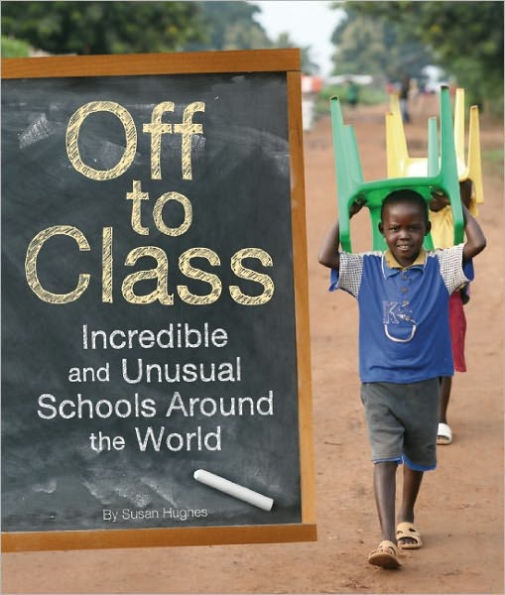Off to Class: Incredible and Unusual Schools Around the World
Travel around the globe to visit some of the world's most incredible schools, and meet the students who attend them, in this best-selling and award-winning nonfiction pick for ages 9 to 12
When North American kids picture a school, odds are they see rows of desks, stacks of textbooks, and linoleum hallways. They probably don’t picture caves, boats, or train platforms — but there are schools in caves, and on boats and on train platforms. There’s a whole world of unusual schools out there!
But the most amazing thing about these schools isn’t their location or what they look like. It’s that they provide a place for students who face some of the toughest environmental and cultural challenges, and live some of the most unique lifestyles, to learn. Education is not readily available for kids everywhere, and many communities are strapped for the resources that would make it easier for kids to go to school. In short, it’s not always easy getting kids off to class — but people around the world are finding creative ways to do it.
In Off to Class, readers will travel to dozens of countries to visit some of these incredible schools, and, through personal interviews, meet the students who attend them, too. And their stories aren't just inspiring — they'll also get kids to think about school and the world in a whole new way!
1102219300
When North American kids picture a school, odds are they see rows of desks, stacks of textbooks, and linoleum hallways. They probably don’t picture caves, boats, or train platforms — but there are schools in caves, and on boats and on train platforms. There’s a whole world of unusual schools out there!
But the most amazing thing about these schools isn’t their location or what they look like. It’s that they provide a place for students who face some of the toughest environmental and cultural challenges, and live some of the most unique lifestyles, to learn. Education is not readily available for kids everywhere, and many communities are strapped for the resources that would make it easier for kids to go to school. In short, it’s not always easy getting kids off to class — but people around the world are finding creative ways to do it.
In Off to Class, readers will travel to dozens of countries to visit some of these incredible schools, and, through personal interviews, meet the students who attend them, too. And their stories aren't just inspiring — they'll also get kids to think about school and the world in a whole new way!
Off to Class: Incredible and Unusual Schools Around the World
Travel around the globe to visit some of the world's most incredible schools, and meet the students who attend them, in this best-selling and award-winning nonfiction pick for ages 9 to 12
When North American kids picture a school, odds are they see rows of desks, stacks of textbooks, and linoleum hallways. They probably don’t picture caves, boats, or train platforms — but there are schools in caves, and on boats and on train platforms. There’s a whole world of unusual schools out there!
But the most amazing thing about these schools isn’t their location or what they look like. It’s that they provide a place for students who face some of the toughest environmental and cultural challenges, and live some of the most unique lifestyles, to learn. Education is not readily available for kids everywhere, and many communities are strapped for the resources that would make it easier for kids to go to school. In short, it’s not always easy getting kids off to class — but people around the world are finding creative ways to do it.
In Off to Class, readers will travel to dozens of countries to visit some of these incredible schools, and, through personal interviews, meet the students who attend them, too. And their stories aren't just inspiring — they'll also get kids to think about school and the world in a whole new way!
When North American kids picture a school, odds are they see rows of desks, stacks of textbooks, and linoleum hallways. They probably don’t picture caves, boats, or train platforms — but there are schools in caves, and on boats and on train platforms. There’s a whole world of unusual schools out there!
But the most amazing thing about these schools isn’t their location or what they look like. It’s that they provide a place for students who face some of the toughest environmental and cultural challenges, and live some of the most unique lifestyles, to learn. Education is not readily available for kids everywhere, and many communities are strapped for the resources that would make it easier for kids to go to school. In short, it’s not always easy getting kids off to class — but people around the world are finding creative ways to do it.
In Off to Class, readers will travel to dozens of countries to visit some of these incredible schools, and, through personal interviews, meet the students who attend them, too. And their stories aren't just inspiring — they'll also get kids to think about school and the world in a whole new way!
14.95
Out Of Stock
5
1

Off to Class: Incredible and Unusual Schools Around the World
64
Off to Class: Incredible and Unusual Schools Around the World
64Related collections and offers
14.95
Out Of Stock

Product Details
| ISBN-13: | 9781926818863 |
|---|---|
| Publisher: | OWLKIDS BOOKS |
| Publication date: | 08/30/2011 |
| Pages: | 64 |
| Product dimensions: | 9.00(w) x 8.50(h) x (d) |
| Lexile: | 950L (what's this?) |
| Age Range: | 9 - 12 Years |
About the Author
From the B&N Reads Blog
